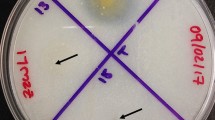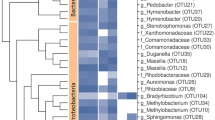Abstract
Plant pathogens, such as fungi, bacteria, and viruses, can cause serious damage to crops and significantly reduce yield and quality. Bacterial diseases of agronomic crops, however, have been little studied. The present study aims to isolate and identify bacteria recovered from symptomatic maize (Zea mays) leaves collected from field samples in the province of Cordoba, Argentina. Bacterial strains were identified using whole-cell matrix-assisted laser-desorption-ionization–time-off light mass spectrometry and 16S rDNA sequencing. Members of the genera Exiguobacterium and Curtobacterium were dominant in the studied vegetal material. Two strains (RC18-1/2 and RC18-3/1) were selected for further studies. The pathogenicity test showed that plants inoculated with Curtobacterium sp. RC18-1/2 exhibited the same symptoms as those previously detected in the field. To our knowledge, this study provides the first evidence about the isolation of a Curtobacterium pathogenic strain in maize. Effective crop disease management will require the use of integrated strategies, such as resistant cultivars and/or biocontrol agents.


Similar content being viewed by others
Data Availability
All phylogeny data are based on accession numbers which are available in Genbank of NCBI database.
References
Tanumihardjoa S, McCulleya L, Roh R, Lopez-Ridaura S, Palacios-Rojas N, Gunaratna NS (2020) Maize agro-food systems to ensure food and nutrition security in reference to the Sustainable Development Goals. Glob Food Sec 25(5):100327. https://doi.org/10.1016/j.gfs.2019.100327
Food and Agriculture Organization of the United Nations (FAO) (2019a) Countries by commodity http://www.fao.org/faostat/en/#rankings/countries_by_commodity (accessed 15–05–21)
Bolsa de Cereales de Córdoba (2019) Córdoba dorada: la importancia de su maíz en el mundo Informe Económico No 277 https://www.bccba.org.ar/informes/cordoba-dorada-la-importancia-de-su-maiz-en-el-mundo/?mode=list (accessed 15–05–21)
Food and Agriculture Organization of the United Nations (FAO) (2019b) Maize production in Argentina http://www.fao.org/faostat/en/#data/QC (accessed 15–05–21)
Velásquez AC, Castroverde CDM, He SY (2018) Plant-Pathogen warfare under changing climate conditions. Curr Biol 28(10):R619–R634. https://doi.org/10.1016/j.cub.2018.03.054
Soliman A, Gulden RH, Tambong JT, Bajracharya P, Adam LR, Xu R et al (2018) Developed and validated inoculation and disease assessment methods for Goss’s bacterial wilt and leaf blight disease of corn. Crop Prot 112:159–167. https://doi.org/10.1016/j.cropro.2018.05.022
Webster BT, Curland RD, McNally RR, Ishimaru CA, Malvick DK (2019) Infection, survival, and growth of Clavibacter nebraskensis on crop, weed, and prairie plant species. Plant Dis 103(8):2108–2112. https://doi.org/10.1094/PDIS-02-19-0346-RE
Korus K, Lang JM, Adesemoye AO, Block CC, Pal N, Leach JE et al (2017) First report of Xanthomonas vasicola causing bacterial leaf streak on corn in the United States. Plant Dis 101(6):1030. https://doi.org/10.1094/PDIS-10-16-1426-PDN
Roper MC (2011) Pantoea stewartii subsp. stewartii: Lessons learned from a xylem-dwelling pathogen of sweet corn. Mol Plant Pathol 12(7):628–637. https://doi.org/10.1111/j.1364-3703.2010.00698.x
Krawczyk K, Foryś J, Nakonieczny M, Tarnawska M, Bereś PK (2021) Transmission of Pantoea ananatis, the causal agent of leaf spot disease of maize (Zea mays), by western corn rootworm (Diabrotica virgifera virgifera LeConte). Crop Prot 141:105431. https://doi.org/10.1016/j.cropro.2020.105431
Lana UGP, Gomes EA, Silva DD, Costa RV, Cota LV, Parreira DF et al (2012) Detection and molecular diversity of Pantoea ananatis associated with white spot disease in maize, sorghum and crabgrass in Brazil. J Phytopathol 160(9):441–448. https://doi.org/10.1111/j.1439-0434.2012.01924.x
Harding M, Nadworny P, Buziak B, Omar A, Daniels G, Feng J (2019) Improved methods for treatment of phytopathogenic biofilms: Metallic compounds as anti-bacterial coatings and fungicide tank-mix partners. Molecules 24(12):2312. https://doi.org/10.3390/molecules24122312
Voloudakis AE, Reignier TM, Cooksey DA (2005) Regulation of resistance to copper in Xanthomonas axonopodis pv. vesicatoria. Appl Environ Microbiol 71(2):782–789. https://doi.org/10.1128/AEM.71.2.782-789.2005
Martins SJ, De Medeiros FHV, de Souza RM, de Resende MLV, Ribeiro PM (2013) Biological control of bacterial wilt of common bean by plant growth-promoting rhizobacteria. Biol Control 66(1):65–71. https://doi.org/10.1016/j.biocontrol.2013.03.009
Alippi AM, López AC (2010) First report of leaf spot disease of maize caused by Pantoea ananatis in Argentina. Plant Dis 94(4):487. https://doi.org/10.1094/pdis-94-4-0487a
Plazas MC, De Rossi RL, Brücher E, Guerra FA, Vilaró M, Guerra GD et al (2018) First report of Xanthomonas vasicola pv. vasculorum causing bacteria leaf streak of maize (Zea mays) in Argentina. Plant Dis 102(5):1025. https://doi.org/10.1094/PDIS-10-17-1578-PDN
Rossi EA, Ruiz M, Bonamico NC, Balzarini MG (2020) Identifying inbred lines with resistance to endemic diseases in exotic maize germplasm. Crop Sci 60(6):3141–3150. https://doi.org/10.1002/csc2.20275
Maier T, Klepel S, Renner U, Kostrzewa M (2006) Fast and reliable MALDI-TOF MS-based microorganism identification. Nat Methods. https://doi.org/10.1038/nmeth870
López JL, Alvarez F, Príncipe A, Salas ME, Lozano MJ, Draghi WO et al (2018) Isolation, taxonomic analysis, and phenotypic characterization of bacterial endophytes present in alfalfa (Medicago sativa) seeds. J Biotechnol 267:55–62. https://doi.org/10.1016/j.jbiotec.2017.12.020
Sogawa K, Watanabe M, Sato K, Segawa S, Ishii C, Miyabe A et al (2011) Use of the MALDI BioTyper system with MALDI-TOF mass spectrometry for rapid identification of microorganisms. Anal Bioanal Chem 400(7):1905–1911. https://doi.org/10.1007/s00216-011-4877-7
Weisburg WG, Barns SM, Pelletier DA, Lane DJ (1991) 16S ribosomal DNA amplification for phylogenetic study. J Bacteriol 173(2):697–703. https://doi.org/10.1128/jb.173.2.697-703.1991
Kumar S, Stecher G, Li M, Knyaz C, Tamura K (2018) MEGA X: Molecular evolutionary genetics analysis across computing platforms. Mol Biol Evol 35(6):1547–1549. https://doi.org/10.1093/molbev/msy096
Felsenstein J (1985) Confidence limits on phylogenies: An approach using the bootstrap. Evolution 39(4):783–791. https://doi.org/10.2307/2408678
De Bruijn FJ (1992) Use of repetitive (repetitive extragenic palindromic and enterobacterial repetitive intergeneric consensus) sequences and the polymerase chain reaction to fingerprint the genomes of Rhizobium meliloti isolates and other soil bacteria. Appl Environ Microbiol 58(7):2180–2187. https://doi.org/10.1128/aem.58.7.2180-2187.1992
Cubero J, Graham JH (2002) Genetic relationship among worldwide strains of Xanthomonas causing canker in citrus species and design of new primers for their identification by PCR. Appl Environ Microbiol 68(3):1257–1264. https://doi.org/10.1128/AEM.68.3.1257-1264.2002
Saddler GS, Guimarāes PM, Hamada M, Suzuki K (2017) Curtobacterium. In: Wiley J, Sons I (eds) Bergey’s manual of systematics of archaea and bacteria. Wiley, Hoboken
Dunleavy JM (1989) Curtobacterium plantarum sp. nov. is ubiquitous in plant leaves and is seed transmitted in soybean and corn. Int J Syst Bacteriol 39:240–249
Chase AB, Arevalo P, Polz MF, Berlemont R, Martiny JBH (2016) Evidence for ecological flexibility in the cosmopolitan genus Curtobacterium. Front Microbiol 7:1–11. https://doi.org/10.3389/fmicb.2016.01874
Osdaghi E, Young AJ, Harveson RM (2020) Bacterial wilt of dry beans caused by Curtobacterium flaccumfaciens pv. flaccumfaciens: a new threat from an old enemy. Mol Plant Pathol 21(5):605–621. https://doi.org/10.1111/mpp.12926
Gonçalves RM, Schipanski CA, Koguishi L, Soman JM, Sakate RK, Silva Júnior TAF et al (2017) Alternative hosts of Curtobacterium flaccumfaciens pv. flaccumfaciens, causal agent of bean bacterial wilt. Eur J Plant Pathol 148:357–365. https://doi.org/10.1007/s10658-016-1094-4
Harveson RM, Schwartz HF, Urrea CA, Yonts CD (2015) Bacterial wilt of dry-edible beans in the central high plains of the US: past, present, and future. Plant Dis 99(12):1665–1677. https://doi.org/10.1094/PDIS-03-15-0299-FE
Yamada K, Komagata K (1972) Taxonomic studies on coryneform bacteria. V. Classification of coryneform bacteria. J Gen Appl Microbiol 18:417–431. https://doi.org/10.2323/jgam.18.417
Collins MD, Jones D (1983) Reclassification of Corynebacterium flaccumfaciens, Corynebacterium betae, Corynebacterium oortii and Corynebacterium poinsettiae in the genus Curtobacterium, as Curtobacterium flaccumfaciens comb. nov. J Gen Microbiol 129:3545–3548
Aizawa T, Ve NB, Kimoto K, Iwabuchi N, Sumida H, Hasegawa I et al (2007) Curtobacterium ammoniigenes sp. nov., an ammonia-producing bacterium isolated from plants inhabiting acidic swamps in actual acid sulfate soil areas of Vietnam. Int J Syst Evol Microbiol 57:1447–1452. https://doi.org/10.1099/ijs.0.64731-0
Behrendt U, Ulrich A, Schumann P, Naumann D, Suzuki K (2002) Diversity of grass-associated Microbacteriaceae isolated from the phyllosphere and litter layer after mulching the sward; polyphasic characterization of Subtercola pratensis sp. nov., Curtobacterium herbarum sp. nov. and Plantibacter flavus gen. nov., sp. nov. Int J Syst Evol Microbiol 52:1441–1454. https://doi.org/10.1099/00207713-52-5-1441
Chen YF, Yin YN, Zhang XM, Guo JH (2007) Curtobacterium flaccumfaciens pv. beticola, a new pathovar of pathogens in sugar beet. Plant Dis 91:677–684. https://doi.org/10.1094/PDIS-91-6-0677
Hedges F (1922) A bacterial wilt of the bean caused by Bacterium flaccumfaciens nov. sp. Science 55:433–434
Keyworth WG, Howell JS, Dowson WJ (1956) Corynebacterium betae (sp. nov.) the causal organism of silvering disease of red beet. Plant Pathol 5:88–90
Saaltink GT, Mass Geesteranus HP (1969) A new disease in tulip caused by Corynebacterium oortii nov. spec. Neth J Plant Pathol 75:123–128
Dye DW, Kemp WJ (1977) A taxonomic study of plant pathogenic Corynebacterium species. New Zealand J Agric Res 20(4):563–582. https://doi.org/10.1080/00288233.1977.10427375
Starr MP, Pirone PP (1942) Phytomonas poinsettiae n. sp., the cause of a bacterial disease of Pointsettia. Phytopathology 32:1076–1081
Gartemann KH, Abt B, Bekel T, Burger A, Engemann J, Flügel M et al (2008) The genome sequence of the tomato-pathogenic actinomycete Clavibacter michiganensis subsp. michiganensis reveals a large island involved in pathogenicity. J Bacteriol Mar 190(6):2138–2149. https://doi.org/10.1128/JB.01595-07
Li X, De Boer SH (1995) Comparison of 16S ribosomal RNA genes in Clavibacter michiganensis subspecies with other coryneform bacteria. Can J Microbiol 41(10):925–929. https://doi.org/10.1139/m95-127
Vauterin L, Hoste B, Kersters K, Swings J (1995) Reclassification of Xanthomonas. Int J Syst Bacteriol 45:472–489. https://doi.org/10.1099/00207713-45-3-472
Dowson WJ (1939) On the systematic position and generic names of the Gram-negative bacterial plant pathogens. Zentralblatt Bakteriol Parasitenkd Infekt Hyg 100:177–193
Mulet M, Gomila M, Gruffaz C, Meyer JM, Palleroni NJ, Lalucat J et al (2008) Phylogenetic analysis and siderotyping as useful tools in the taxonomy of Pseudomonas stutzeri: description of a novel genomovar. Int J Syst Evol Microbiol 58(Pt 10):2309–2315. https://doi.org/10.1099/ijs.0.65797-0 (PMID: 18842847)
Van Hall CJJ (1902) Bijdragen tot de kennis der Bakterieele Plantenziekten. Inaugural Dissertation Amsterdam. Cooperatieve drukkerij-vereeniging "Plantijn".
Mergaert J, Verdonck L, Kersters K (1993) Transfer of Erwinia ananas (synonym, Erwinia uredovora) and Erwinia stewartii to the genus Pantoea emend. as Pantoea ananas (Serrano 1928) comb. nov. and Pantoea stewartii (Smith 1898) comb. nov., respectively, and description of Pantoea stewartii subsp. indologenes subsp. nov. Int J Syst Bacteriol 43:162–173. https://doi.org/10.1099/00207713-43-1-162
Gavini F, Mergaert J, Beji A, Mielcarek C, Izard D, Kersters K et al (1989) Transfer of Enterobacter agglomerans (Beijerinck 1888) Ewing and Fife 1972 to Pantoea gen. nov. as Pantoea agglomerans comb. nov. and description of Pantoea dispersa sp. nov. Int J Syst Bacteriol 39:337–345. https://doi.org/10.1099/00207713-39-3-337
Coutinho TA, Preisig O, Mergaert J, Cnockaert MC, Riedel KH, Swings J et al (2002) Bacterial blight and dieback of Eucalyptus species, hybrids, and clones in South Africa. Plant Dis 86:20–25. https://doi.org/10.1094/PDIS.2002.86.1.20
Acknowledgements
The authors thank the Agencia Nacional de Promoción Científica y Tecnológica, Universidad Nacional de Río Cuarto and CONICET for financial support. M. Balzarini, A. Lagares and S. Fischer are members of the Scientific Researcher Career−CONICET. N. Bonamico is Scientific Researcher of UNRC. V. López-Ramírez, M. Ruíz, E. Rossi and N. Zuber are fellows of CONICET.
Funding
This research was supported by the Agencia Nacional de Promoción Científica y Tecnológica (PICT 0850/16, 2898/19), Secretaría de Ciencia y Técnica de la Universidad Nacional de Río Cuarto (Res. 083/2020). CONICET-PUE (22920200100006CO and 22920180100064).
Author information
Authors and Affiliations
Contributions
VLR, MR, ER, and NZ conceived and performed the experiments. AL, MB, NB, and SF designed the experiments. VLR and SF wrote the manuscript. All authors read, corrected, and approved the final manuscript.
Corresponding author
Ethics declarations
Conflict of Interest
The authors declare that they have no conflict of interest.
Ethical Approval
This article does not contain any studies with human participants or animals performed by any of the authors.
Consent for Publication
All authors have agreed on the consent of the manuscript.
Additional information
Publisher's Note
Springer Nature remains neutral with regard to jurisdictional claims in published maps and institutional affiliations.
Rights and permissions
About this article
Cite this article
López-Ramírez, V., Ruíz, M., Rossi, E. et al. Curtobacterium, A Foliar Pathogen Isolated from Maize in Central Argentina. Curr Microbiol 79, 261 (2022). https://doi.org/10.1007/s00284-022-02953-y
Received:
Accepted:
Published:
DOI: https://doi.org/10.1007/s00284-022-02953-y




